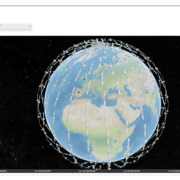SatCom capacity according to demand – Flexible resource management via C-DReAM
The low earth orbit (LEO) satellites’ resource allocation should take into account the changes in geographical and temporal traffic demand. Continuously growing amount of satellite communications traffic shall be a burden on the satellites. To solve this problem Magister Solutions is building a simulator that optimises the use of resources and makes sure they are where they are most needed – when they are needed.
As the need for satellite communications grows, the LEO satellites get more and more burdened. Why should the LEO satellites share their capacity evenly, despite the fact that population density and time of day mean the demand is not the same everywhere all the time?
Intelligent resource management offers the possibility to optimize the use of the capacity – based on life on earth. We at Magister with Thales Alenia Space France are developing a resource management algorithm in European Space Agency’s C-DReAM (Constellation – Dynamic Resource Allocation Management) project that will be able to optimize the allocation of resources of a non-geostationary satellite orbit (NGSO) satellite constellation.
By adjusting to the capacity on-a-need-basis, the NGSO constellation will be able to provide more capacity to peak times and areas and improve the quality of services. The network capacity can also be dimensioned based on the average volume likely reducing the cost of the system.
NGSO satellite constellation – Matching capacity to demand
The use of a current NGSO satellite constellation offers many advantages for communication missions: potential global coverage, low delay transmission, increased robustness and potentially lower costs of gigabit per second. But it also has its challenges: SatCom capacity is traditionally uniformly distributed, but the data demand is not. Therefore the actual system throughput can be severely limited.
So what has to change? Satellite networks need to introduce flexible payloads allowing them to match the capacity to the actual traffic demand and like this maximise their throughput:
– We need to get more capacity to peak times and areas. Could it be done by moving the capacity, bandwidth and/or time, to more crowded areas and busier times to the day or by aggressive frequency reuse and downsizing the beams over smaller areas? There are several possibilities, so we need an algorithm that is able to find a “good enough” allocation in a reasonable amount of time, explains Magister Solutions’ Research Director Janne Kurjenniemi.
The simplest solution – heuristic strategies – would allow NGSO satellite constellations to converge to a suboptimal solution in a single iteration. However, more advanced and more complex iterative optimization algorithms would allow reaching better performance – but also with longer convergence times.
The best solution most probably lies somewhere in between: an acceptable tradeoff between system performance and convergence time. The algorithm options shall be implemented and evaluated using a software simulator developed by Magister.
Simulating the resource management algorithm
Magister and Thales Alenia Space France are working together to find the most suitable algorithms in the C-DReAM project. Thales Alenia Space France sets the requirements, defines the scenario and also examines how the resources should be shared. Magister is responsible for simulator design, development, simulations executions and results analysis.
Once in use, the resource management algorithm will be able to optimize the resource allocation of a NGSO satellite constellation. Optimization will be based on the geographical and temporal variations in the traffic demand. It also will demonstrate how such an algorithm can converge fast enough to be operationally useful.
– We will develop a software simulator modelling the NGSO system in terms of traffic, user terminal characteristics, channel model, antenna and payload model, orbit propagation, etc. The resource allocation algorithms shall be evaluated with our simulator e.g. in terms of throughput performance and run-time complexity, Kurjenniemi says.
The system demonstrator will allow the user to configure different system scenarios, e.g. satellite constellations. It will also be designed to interface with alternative radio resource management (RRM) algorithms, potentially developed by the user.
Could Simulations as a Service make a difference to your business? Read more here!
Summary:
- Magister and Thales Alenia Space France are developing a resource management algorithm that seeks to optimize the resource allocation of a NGSO satellite constellation.
- Satellite networks need to introduce flexible payloads allowing them to match their capacity to the traffic demand and thus maximise their throughput.
- Magister is building a simulator which will help to explore the possibilities of resource management.
Keywords: SatCom, TeleCom, NGSO, LEO satellite, simulator, C-DReAM









